仁爱版七年级英语下册U6T1SC教学设计
仁爱初一Unit6Topic1详案(仁爱版七年级英语下册教案教学设计)
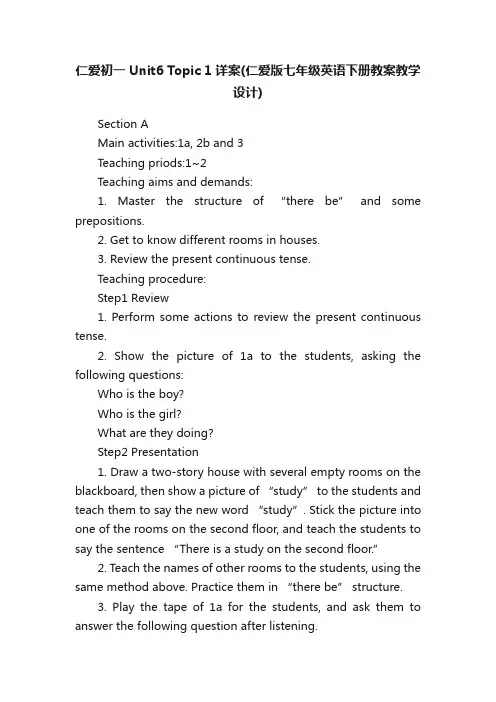
仁爱初一 Unit6 Topic 1 详案(仁爱版七年级英语下册教案教学设计)Section AMain activities:1a, 2b and 3Teaching priods:1~2Teaching aims and demands:1. Master the structure of “there be” and some prepositions.2. Get to know different rooms in houses.3. Review the present continuous tense.Teaching procedure:Step1 Review1. Perform some actions to review the present continuous tense.2. Show the picture of 1a to the students, asking the following questions:Who is the boy?Who is the girl?What are they doing?Step2 Presentation1. Draw a two-story house with several empty rooms on the blackboard, then show a picture of “study” to the students and teach them to say the new word “study”. Stick the picture into one of the rooms on the second floor, and teach the students to say the sentence “There is a study on the second floor.”2. Teach the names of other rooms to the students, using the same method above. Practice them in “there be” structure.3. Play the tape of 1a for the students, and ask them to answer the following question after listening.“Is there a computer in Jane’s study?”4. Go through the dialog with the students together, and deal with some language points.Write them down on the blackboard.Is there…Are there…Next to…Why not…Can I borrow…Step3 Consolidation1. Play the tape again and ask the students to follow it sentence by sentence, paying attention to the pronunciation and intonation.2. Get the students to practice and act out the dialog. Choose several pairs to act out in the front of the class.Step4 Practice1. Finish 2a and 2b in class.2. Review the present continuous tense.3. Practice 3.4. Choose several pairs to act out their dialog 3.Step5 Project1. Finish 4.2. Suppose a classmate or a friend is visiting your home. Make a dialog with your partner, using “there be” structure and the present continuous tense. List the following suggestion on the blackboard.There is…Is there…? Yes, there is./No, there isn’t.There a re…Are there …? Yes, there are./No, there aren’t.What’s on the first /second floor?What’s your mother/father …doing in the garden?He/she is V-ing…3. Choose several pairs to act out their dialog.Section BMain activities:1a and 3Teaching priods:1~2Teaching aims and demands:1. Learn more preposition of position in “there be” structure.2. Learn wh-question.3. Learn some home items.Teaching procedure:Step1 Review1. Review the main contents of Section A by brainstorming.For example:Does Jane have a nice house?Is there a garden beside he house?Where is the bedroom?2. GameDivide the class into two groups, and ask each group to speak out different rooms and prepositions they have learned one by one without long pause and repetition.Step2 Presentation1. Present the new words, using pictures or real objects.For example:Take out a mirror to teach the new word “mirror”, and put the mirror on the desk to teach the sentence “There is a mirror on the desk.”2. Teach the other home items and preposition, using thesame method above.3. Give the question: Who is playing with the computer? And then play the tape. Ask the students to answer the question after listening.4. Go through the dialog of 1a with the students, and list some key points on the blackboard and give necessary explanation, such as lamp, mirror and clock.Step3 Consolidation1. Play the tape of 1a again, and ask the students to follow it sentence by sentence, paying attention to the pronunciation and intonation.2. Get the students to practice the dialog in pairs, and then choose several pairs to act it out in class.3. Finish 2 in groups and check the answer together with the students. Give explanation if necessary.Step4 Practice1. Finish the rest part of 3 according to the example shown. Choose several pairs to act out their dialog.2. Look at the picture and finish 4.Step5 Project1. Suppose you’ve just moved into a new flat and need to buy many home items. Make a shopping list and then make up a short dialog about shopping. Act out your dialog with your partner in class.2. Classify the home items you have bought to see which items should be put into which room. List the items on the blackboard. Report your answer to the class.Section CMain activities:1a and 2Teaching priods:1Teaching aims and demands:1. Go on learning “there be” structure.2. Go on learning preposition of position.Teaching procedure:Step1 ReviewGuess a riddleThe teacher writes the first letter of a word on the blackboard, and gets the students to guess. Practice the first one whose guess is correct. If nobody can get he answer, the teacher can give some necessary English explanation.Step2 Presentation1. Ask the students to read 1a quickly and then finish the true or false questions.2. Do intensive reading again and ask the students to finish 1b alone. Check the answers in class and give necessary explanation.3. List some key words and sentences on the blackboard, and draw a stick figure on the blackboard. Retell the passage according to the key words and picture to show a model. Get the students to practice in pairs or groups.Step3 Consolidation1. Ask the students to finish 2 with the prepositions “in, on, under, behind, in front of” alone. Then check the answers in class and give necessary explanation.2. Ask the students to work in pairs to find the differences between the two pictures in3. Make a list of differences and then finish the blanks in pairs.Step4 Practice1. Find out the key words and sentences with the students. And then list them on the blackboard. The teacher gives a modelto retell the passage according to the key points, and then ask the students to retell the passage.For example:The curtain in Picture A, In Picture B, There is, In Picture, There is a bookcase, In the bookcase2. Sentence making game.List the following words on the blackboard.Step5 ProjectChain story.Make out a story in class. Everybody should try to make the story interesting and vivid.The teacher can begin the story like this:There is a beautiful girl in front of a big garden.Section DMain activities:1,4 and 5Teaching priods:1Teaching aims and demands:1. Review the main contents of Topic 1.2. Learn consonants.Teaching procedure:Step1 Review1. Use 3a and 3b as a clue to review the main contents of this topic.2. Share the story the students made during the last period.Step2 Presentation1. Put the words in 1 on the blackboard at random, ask the students to classify them according to the pronunciation, and ask them to read after the tape for several times.2. touching game-Hungry Shark1) Stick the following pictures at the bottom of theblackboard, and draw a picture like this:2) Divide the students into two groups and number each student in wither group so that there are two students who have the same number.3) Make enough room for running. The teacher speaks out a word first and then calls a number to see which student can touch the picture faster and correctly.4) The loser must come down one step from the stair.5) Call out different numbers and words faster and faster. The game is over when one group falls down into the mouth of the hungry shark.Step3 Consolidation1. Ask the students to finish the letter in 4 within a limited period, and ask one or two volunteers to read the letter in the front of the class.2. The rest of the class can ask questions according to the content of the letter.Step4 Practice1. Ask the students to draw a picture including the following words:a house, trees, a river, a yard, a boat, birds, a girl, a bridge, a dog, a lake2. Ask the students to describe their pictures orally, choose one or two volunteers to share their picture and passages with the class.Step5 ProjectFinish drawing the picture according to the cassette of 2.~。
仁爱英语七下教案U6T1SA
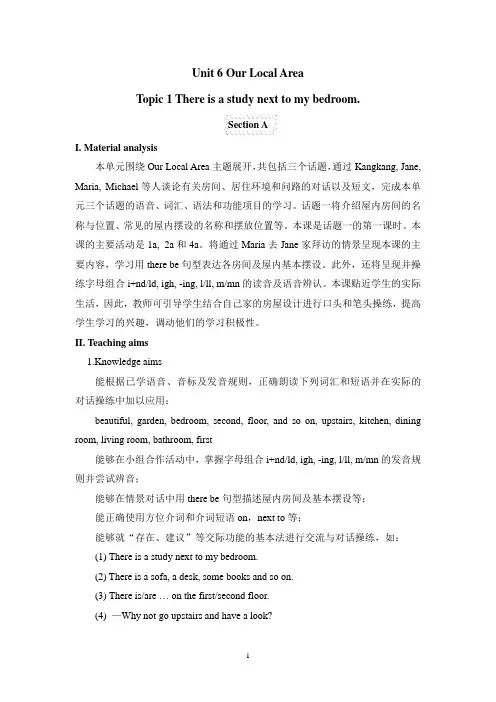
Unit 6 Our Local AreaTopic 1 There is a study next to my bedroom.Section AI. Material analysis本单元围绕Our Local Area主题展开,共包括三个话题,通过Kangkang, Jane, Maria, Michael等人谈论有关房间、居住环境和问路的对话以及短文,完成本单元三个话题的语音、词汇、语法和功能项目的学习。
话题一将介绍屋内房间的名称与位置、常见的屋内摆设的名称和摆放位置等。
本课是话题一的第一课时。
本课的主要活动是1a, 2a和4a。
将通过Maria去Jane家拜访的情景呈现本课的主要内容,学习用there be句型表达各房间及屋内基本摆设。
此外,还将呈现并操练字母组合i+nd/ld, igh, -ing, l/ll, m/mn的读音及语音辨认。
本课贴近学生的实际生活,因此,教师可引导学生结合自己家的房屋设计进行口头和笔头操练,提高学生学习的兴趣,调动他们的学习积极性。
II. Teaching aims1.Knowledge aims能根据已学语音、音标及发音规则,正确朗读下列词汇和短语并在实际的对话操练中加以应用:beautiful, garden, bedroom, second, floor, and so on, upstairs, kitchen, dining room, living room, bathroom, first能够在小组合作活动中,掌握字母组合i+nd/ld, igh, -ing, l/ll, m/mn的发音规则并尝试辨音;能够在情景对话中用there be句型描述屋内房间及基本摆设等;能正确使用方位介词和介词短语on,next to等;能够就“存在、建议”等交际功能的基本法进行交流与对话操练,如:(1)There is a study next to my bedroom.(2) There is a sofa, a desk, some books and so on.(3) There is/are … on the first/second floor.(4) —Why not go upstairs and have a look?—Let’s go. ...2.Skill aims能听懂谈论房间、室内摆设的表达,并做出恰当回应;能就房间、室内摆设进行简单的交流;能在口头表达中做到发音清晰,语音语调准确;能正确朗读对话,注意语音语调和单词重音;能准确写出黑体单词和词组。
仁爱初中英语七下精品教案设计U6T1SC
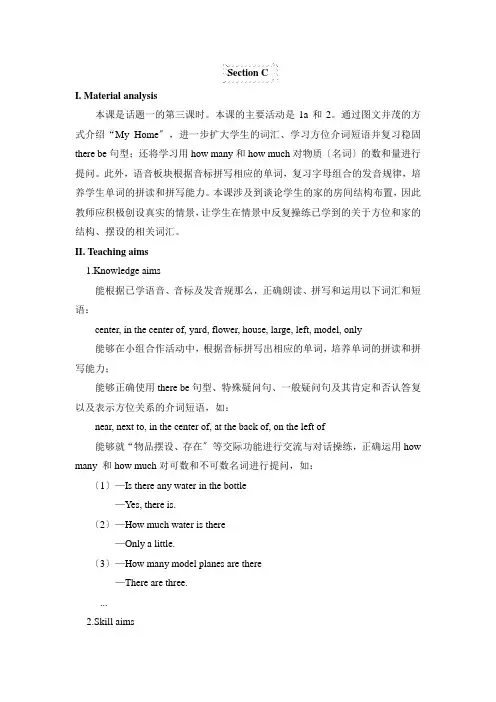
Section CI. Material analysis本课是话题一的第三课时。
本课的主要活动是1a和2。
通过图文并茂的方式介绍“My Home〞,进一步扩大学生的词汇、学习方位介词短语并复习稳固there be句型;还将学习用how many和how much对物质〔名词〕的数和量进行提问。
此外,语音板块根据音标拼写相应的单词,复习字母组合的发音规律,培养学生单词的拼读和拼写能力。
本课涉及到谈论学生的家的房间结构布置,因此教师应积极创设真实的情景,让学生在情景中反复操练已学到的关于方位和家的结构、摆设的相关词汇。
II. Teaching aims1.Knowledge aims能根据已学语音、音标及发音规那么,正确朗读、拼写和运用以下词汇和短语:center, in the center of, yard, flower, house, large, left, model, only能够在小组合作活动中,根据音标拼写出相应的单词,培养单词的拼读和拼写能力;能够正确使用there be句型、特殊疑问句、一般疑问句及其肯定和否认答复以及表示方位关系的介词短语,如:near, next to, in the center of, at the back of, on the left of能够就“物品摆设、存在〞等交际功能进行交流与对话操练,正确运用how many 和how much对可数和不可数名词进行提问,如:〔1〕—Is there any water in the bottle—Yes, there is.〔2〕—How much water is there—Only a little.〔3〕—How many model planes are there—There are three....2.Skill aims能识别出不同的语调,如陈述句和疑问句等;能听懂谈论房间、室内摆设的表达,并做出恰当回应;能对房间、室内摆设进行简单的交流;能在口头表达中做到发音清晰,语音语调准确;能在图画的帮助下进行阅读,并按要求进行语言活动;能正确拼读单词,注意单词重音;能准确写出黑体单词和词组;能根据范文写出介绍自己家的小短文。
英语初一下仁爱湘教版英语:unit6topic3教案
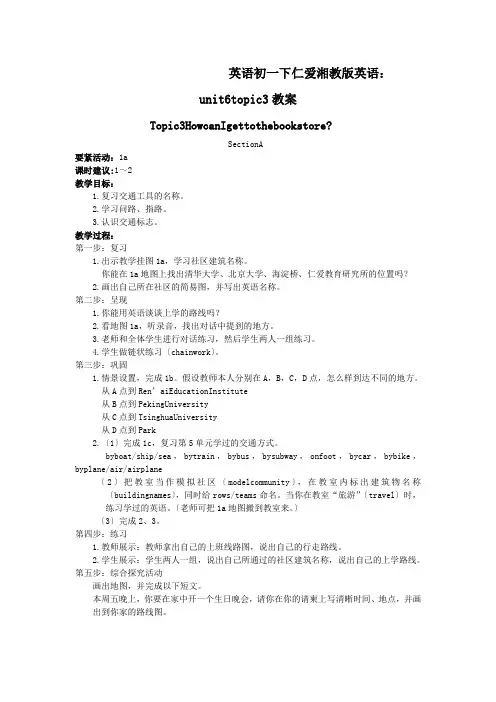
英语初一下仁爱湘教版英语:unit6topic3教案Topic3HowcanIgettothebookstore?SectionA要紧活动:1a课时建议:1~2教学目标:1.复习交通工具的名称。
2.学习问路、指路。
3.认识交通标志。
教学过程:第一步:复习1.出示教学挂图1a,学习社区建筑名称。
你能在1a地图上找出清华大学、北京大学、海淀桥、仁爱教育研究所的位置吗?2.画出自己所在社区的简易图,并写出英语名称。
第二步:呈现1.你能用英语谈谈上学的路线吗?2.看地图1a,听录音,找出对话中提到的地方。
3.老师和全体学生进行对话练习,然后学生两人一组练习。
4.学生做链状练习〔chainwork〕。
第三步:巩固1.情景设置,完成1b。
假设教师本人分别在A,B,C,D点,怎么样到达不同的地方。
从A点到Ren’aiEducationInstitute从B点到PekingUniversity从C点到TsinghuaUniversity从D点到Park2.〔1〕完成1c,复习第5单元学过的交通方式。
byboat/ship/sea,bytrain,bybus,bysubway,onfoot,bycar,bybike,byplane/air/airplane〔2〕把教室当作模拟社区〔modelcommunity〕,在教室内标出建筑物名称〔buildingnames〕,同时给rows/teams命名。
当你在教室“旅游”〔travel〕时,练习学过的英语。
〔老师可把1a地图搬到教室来。
〕〔3〕完成2、3。
第四步:练习1.教师展示:教师拿出自己的上班线路图,说出自己的行走路线。
2.学生展示:学生两人一组,说出自己所通过的社区建筑名称,说出自己的上学路线。
第五步:综合探究活动画出地图,并完成以下短文。
本周五晚上,你要在家中开一个生日晚会,请你在你的请柬上写清晰时间、地点,并画出到你家的路线图。
Mainactivities:1aTeachingperiods:1~2Teachingaimsanddemands:1.Reviewthenamesoftransportation.2.Learnhowtoaskandshowdirections.3.Learnthetrafficsigns.Teachingprocedure:Step1Review1.Showthepictures.Learnthenamesofthebuildingsinyourarea.CanyoufindTsinghuaUniversity,PekingUniversity,HaidianBridgeandRen’aiEducationInstituteinthemap?2.Drawasimplemapofyourcommunityandsignthenamesonit.Step2Presentation1.Canyoushowusthewaytoyourschool?2.Readthemap1a.Listentothetape.Findouttheplacesmentionedinthedialog.3.Theteacherandthestudentspracticethedialogfirst,andthendopairwork.4.Dothechainwork.Step3Consolidation1.Setupasituationandfinish1b.SupposeyouarestandingatA,B,CorD,howcanyougettothefollowingdifferentplaces?FrompointAtoRen’aiEducationInstituteFrompointBtoPekingUniversityFrompointCtoTsinghuaUniversityFrompointDtoPark2.〔1〕Finish1c.ReviewthenamesoftransportationinUnit5.byboat/ship/sea,bytrain,bybus,bysubway,onfoot,bycar,bybike,byplane/air/airplane〔2〕Settheclassroomas “modelcommunity”.Putthebuildingnamecardsinsomeplacesintheclassroomandgiveanametoeachrow/team.Andthenpracticethedialogwhileyouare“travelling”intheclassroom.Thismeansyoucan“print”themapinsectionA1aintotheclassroom.〔3〕Finish2and3.Step4Practice1.Theteachershowsthemapofwayhomeandspeakoutthemainbuildingsandhowtogethomefromschool.2.Studentsinpairsspeakoutthemainbuildingsintheirareaandhowtheycangettoschoo l.Step5ProjectDrawamapandfinishthefollowingpassage.ThisFridayeveningyouaregoingtohaveabirthdaypartyinyourhome.Pleasewritetheti meandplaceontheinvitationanddrawthemapofwaytoyourhome.要紧活动:1a和2课时建议:1教学目标:1.复习SectionA中学过的问路和指路。
仁爱初中英语七年级下册《Unit 6Topic 1 Is there a computer in your studyB》精品教案 (1)
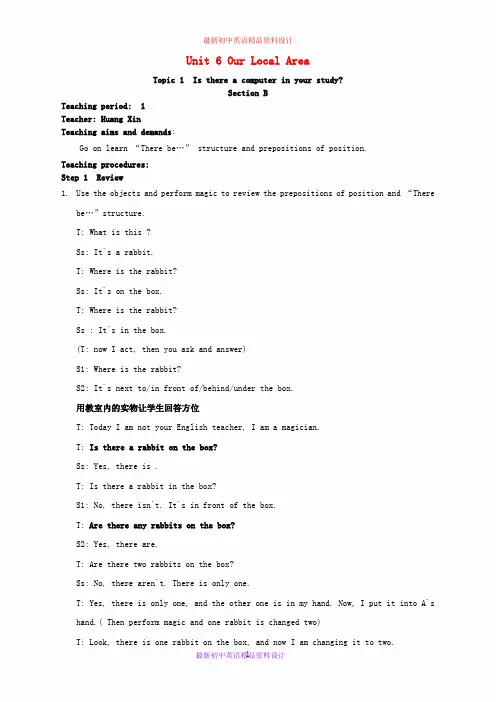
Unit 6 Our Local AreaTopic 1 Is there a computer in your study?Section BTeaching period: 1Teacher: Huang XinTeaching aims and demands:Go on learn “There be…” structure and prepositions of position.Teaching procedures:Step 1 Reviewe the objects and perform magic to review the prepositions of position and “Therebe…”structure.T: What is this ?Ss: It`s a rabbit.T: Where is the rabbit?Ss: It`s on the box.T: Where is the rabbit?Ss : It`s in the box.(T: now I act, then you ask and answer)S1: Where is the rabbit?S2: It`s next to/in front of/behind/under the box.用教室内的实物让学生回答方位T: Today I am not your English teacher, I am a magician.T: Is there a rabbit on the box?Ss: Yes, there is .T: Is there a rabbit in the box?S1: No, there isn`t. It`s in front of the box.T: Are there any rabbits on the box?S2: Yes, there are.T: Are there two rabbits on the box?Ss: No, there aren`t. There is only one.T: Yes, there is only one, and the other one is in my hand. Now, I put it into A`s hand.( Then perform magic and one rabbit is changed two)T: Look, there is one rabbit on the box, and now I am changing it to two.T: (Take out a box) Is there a book in the box?Ss: Yes, there is.T: Is there a cup in the box?Ss: No, there isn`t. There is a book.T: Are there any cups in the box?S3: Yes, there are.T: Are there any rabbits in the box?Ss: No, there aren`t.T: Right. There is nothing in the box. Nothing , really? Oh,no, there is a small box in it. And in the a small box there are two flowers.( Take out three small boxes from the big boxes by performing magic把句型跟学生进行解释(these are the sentences we have learned yesterday. Pay attention to singular number and even numbers. Now read after me)Step 2 Presentation1.Show a plan of an apartment on the screen.T: Look. Here is my new apartment. What’s in it?Ss: There is a bathroom, a dinning room, a kitchen, a living room, a study, a garden and two bed rooms.T: Right, now guess “What’s in my study?”Ss: Is there a …? / Are there any…?2.T: Great, look! Here is my study. Can you tell me what is on the table?Ss: There is a clock.T: And…Ss: There are some books.板书并告诉学生无论单数还是复数都是用what`s 来问,但是单数就用there is 来回答,复数用there are 来回答。
仁爱七年级Unit 6,Topic 1四个课时教学设计
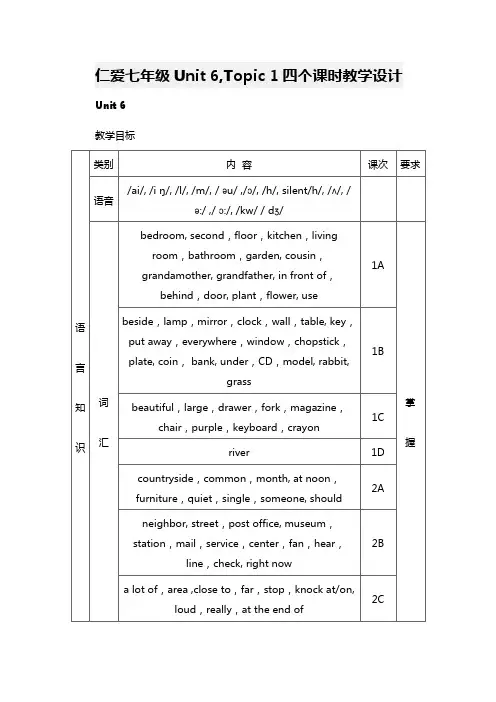
仁爱七年级Unit 6,Topic 1四个课时教学设计Unit 6教学目标1there be 句型There is a small garden in front of my house.There is a lamp, a mirror, a computer and some books on it.There are so many nice books on the shelf.Is there...? Yes, there is. /No, there isn’t.Are there any...? Yes, there are./No, there aren’t.How many...? There are...2Wh- question Wh- 问题What’s on the table? There are some keys on it.Where’s the living room? It’s on the first floor.3on,in,at,behind,under,in front of,near,across, from,nextto,nearTeaching Design for Section A, Topic1 in Unit6 Teaching Aims:1 To learn and use the new words & phrases about different kinds of rooms in our house:e.g. bedroom, kitchen, dining room, living room.And some other new words:e.g. second, floor, upstairs, come in, garden, grandfather, in front of, house, behind, door2 To learn several prepositions of position:e.g. in,on,next to, infront of, behindTo review some other prepositions:e.g., on the left/right, in the center of, near, at the back of3 To learn how to use “there be”e.g. There is a book on the shelfThere are many books on the shelf.Is there/Are there many books on the shelf?Yes, there is./No,there isn’t.Yes, there are./No,there aren’t.4 To learn the sounds/ai/, /i ŋ/, /l/, /m/ with the words.e.g., find, child, high, light, eating, sing, leaf, mad, autumn.Teaching Procedures:Step1. Revision/ using pictures to present the new words about different kinds of rooms in a house.T: (Greeting) what day is it today?Ss: Today is Tuesday.T: What chass are we having:Ss: We are having an English class.T: Where are we now?Ss: We are in the classroom building, and we are on the third floor.T: Now, look here. What’s this?Ss: It’s a living room.T: Is there a bed in the living room?Ss: No, there isn’t.(living room, dining room, kitchen, garden, house)Step2. Listen and match for 2a (P25) to practice new words.And then ask, several questions about 2a.Qs: Is there a bed in the bedroom?Are there two pairs of shoes in the bedroom?Step3. Listen, read and act it out for 1a.Listen and answer the questions:Qs:1. Where is Jane’s bedroom?2. Are there many books on the shelf?Read it and try to act it out.Step4 Listen and read the sounds and words aloud, then summarize the sounds .Finish the exercise in 4b.Step5. Pairwork (Make conversations for 2a),and then try to act it out.Step6. Summary and assignment.Assignment: 1.描述一下你房间里的所有物(There be…)2.描述一下你的家。
仁爱版七年级英语下册教案:U6T1SC教案
(2)1b. Read 1a and answer the following questions.
1. What’s in the center of the yard?
2. What’s at the back of the yard?
A.some;some B.some;any
C.any;some D.any;any
4.---_______ water ______ there in the glass?
3、中招考点:
There be句型和方位介词短语的用法,是学生必须掌握的知识要点,所以一定要让学生弄明白。
4、学情分析:
There be句型对于刚学的学生比较难,且本班学生英语学科基础较差,部分学生学习兴趣不是很足。鉴于这一点,上课前应当充分备足课,多举例,努力提高学生的学习兴趣,帮助学生打好基础。
基于“课程标准、中招视野、两类结构”
七(上)Unit6 Topic1 Section C教案设计
(新授课)
一、学习目标确定的依据:
1、课程标准相关要求:《英语课程标准》(2011年版)要求学生能够会读会写知汉意的单词和短语
单词:center, yard, flower, house, large, left, model,only
(1)Read 1a again and underline the phrases, such as in the center of, at the back of, on the left of.
(2)短语汉译英
在...的中心
在...左/右边
靠近/紧挨着
最新仁爱版七年级英语下册Unit6Topic1IsthereacomputerinyourstudyC优质教案(2)
学习内容1) 词汇:center ,in the center of,yard,beautiful,flo wer,large,left,people,mirror,drawer,chair,keyboard,penc il-boxat the back of, on the left/right of2)句子:On the left of the yard,there is a kitchen and a dining room.I love playing on the computer in the study.Where is the...? It's ...Where are the...?They are...There is /are...学习目标1.学习一些新单词;2.继续学习方位介词和There be……句型。
自主学习1. 检测新单词:在……中心院子美丽的,花,巨大的,左边,人,人们抽屉,键盘,文具盒,椅子,镜子在左面、右面.前面.后面_______________________________2. 预习29页的短文,画出介词短语。
3.预习填空完成30页的2和3.合作交流1.讨论图片,复习句型:A:What’s in/on/under/in front of/behind 。
?B:There is/are 。
2.讨论图片,回答下列问题。
a)What's in the center of the home?b) What's at the back of the yard?c) What's on the left of the yard?4). What's on the right of the yard?班级展示1.对上述的对话展示。
问答家里前后左右的东西。
There is a small garden in the center of it.There is a nice house at the back of it.2.Work alone. 回答问题。
仁爱英语七下U6T1SA教学设计
仁爱英语七下U6T1SA教学设计仁爱七年级Teaching plan for Unit 6, T opic 1, Section A Is there a computer in your study? 教学设计刘国蓉Section A needs 1 period.Ⅰ. Learning aims1) Knowledge objectives:1.Learn some new words and expressions:garden, bedroom, second, floor, next to, upstairs, come in, kitchen, bathroom, front, house, grandfather, behind, door2. Learn the sentence patterns:There is /There are…Is there a …? Yes, there is. No, there isn’t.Are t here any …? Yes, there are. No, there aren’t.2). Ability objectives:1. Learn prepositions and prepositional phrases of position.2. Be able to simply talk about one’s home.3) Moral objectives:1.Make the students talk about their homes and learn to be friendly to each other .Ⅱ. Teaching difficulties and key points:The names of the rooms and how to talk about people’s house.Ⅲ.Teaching aids:ppt, VideoⅣ. Teaching procedures:Step 1 组织教学和free talk 。
仁爱版英语七年级下册Unit6单元教学设计
1.词汇和短语的学习与运用是本章节的重点,特别是环保相关词汇的掌握,如:pollution, recycle, volunteer等。学生需要能够在实际语境中正确使用这些词汇进行表达。
设想:通过词汇卡片游戏、词汇接龙等活动,让学生在轻松愉快的氛围中学习新词汇,同时结合生活实例,加深对词汇意义的理解。
为了巩固本章节的学习内容,确保学生对环保主题的理解和应用,特布置以下作业:
1.词汇巩固:请学生选择本单元的五个环保相关词汇,用英文解释其含义,并造一个句子来展示其用法。这不仅能帮助学生记忆单词,还能提高他们运用词汇的能力。
2.语法练习:完成一份一般现在时态的练习册,其中包括填空、改错和句型转换等多种题型,旨在让学生通过实际操作,熟练掌握时态的运用。
4.提高学生的阅读理解能力,通过阅读课文,了解环保相关的信息,提取关键信息,完成相应的阅读练习。
5.培养学生的写作能力,能够根据本单元的话题,撰写一篇关于环保的短文,表达自己的观点和建议。
(二)过程与方法
在本章节的学习过程中,教师将采用以下方法引导学生掌握所学知识与技能:
1.采用任务型教学法,设计丰富多样的课堂活动,如小组讨论、角色扮演、调查问卷等,让学生在实践中学习英语,提高语言运用能力。
4.通过学习英语,拓宽学生的国际视野,让他们了解世界各地的环保现状,学会尊重不同文化背景下的环保观念。
5.培养学生积极向上、乐观进取的人生态度,让他们相信自己有能力改变现状,为实现美好未来而努力奋斗。
二、学情分析
针对仁爱版英语七年级下册Unit 6的教学内容,结合学生的实际情况,进行以下学情分析:
1.学生已经具备一定的英语基础知识,能够运用简单的日常用语进行交流,但在词汇量和语法知识方面仍有待提高。因此,在本章节的教学中,应注重词汇和语法的讲解与巩固。
- 1、下载文档前请自行甄别文档内容的完整性,平台不提供额外的编辑、内容补充、找答案等附加服务。
- 2、"仅部分预览"的文档,不可在线预览部分如存在完整性等问题,可反馈申请退款(可完整预览的文档不适用该条件!)。
- 3、如文档侵犯您的权益,请联系客服反馈,我们会尽快为您处理(人工客服工作时间:9:00-18:30)。
Section CI. Material analysis本课是话题一的第三课时。
本课的主要活动是1a和2。
通过图文并茂的方式介绍“My Home”,进一步扩大学生的词汇、学习方位介词短语并复习巩固there be句型;还将学习用how many和how much对物质(名词)的数和量进行提问。
此外,语音板块根据音标拼写相应的单词,复习字母组合的发音规律,培养学生单词的拼读和拼写能力。
本课涉及到谈论学生的家的房间结构布置,因此教师应积极创设真实的情景,让学生在情景中反复操练已学到的关于方位和家的结构、摆设的相关词汇。
II. Teaching aims1.Knowledge aims能根据已学语音、音标及发音规则,正确朗读、拼写和运用下列词汇和短语:center, in the center of, yard, flower, house, large, left, model, only能够在小组合作活动中,根据音标拼写出相应的单词,培养单词的拼读和拼写能力;能够正确使用there be句型、特殊疑问句、一般疑问句及其肯定和否定回答以及表示方位关系的介词短语,如:near, next to, in the center of, at the back of, on the left of能够就“物品摆设、存在”等交际功能进行交流与对话操练,正确运用how many 和how much对可数和不可数名词进行提问,如:(1)—Is there any water in the bottle?—Yes, there is.(2)—How much water is there?—Only a little.(3)—How many model planes are there?—There are three....2.Skill aims能识别出不同的语调,如陈述句和疑问句等;能听懂谈论房间、室内摆设的表达,并做出恰当回应;能对房间、室内摆设进行简单的交流;能在口头表达中做到发音清晰,语音语调准确;能在图画的帮助下进行阅读,并按要求进行语言活动;能正确拼读单词,注意单词重音;能准确写出黑体单词和词组;能根据范文写出介绍自己家的小短文。
3.Emotional aims能在学习的同时,热爱自己的生活环境;能认真、规范地书写单词;能够与同伴积极合作,参与课堂活动,大胆实践。
III. The key points and difficult points1.能够在情景对话中,熟练运用there be句型的复数、特殊疑问句、一般疑问句及其肯定和否定回答以及表示方位关系的短语谈论房间分布、物品摆设和方位;2.能正确使用how many和how much对可数名词的数和不可数名词的量进行提问。
IV. Learning strategies1.能与他人合作,共同完成学习任务;2.能逐步养成预习和复习的好习惯;3.能够运用图片、关键词和实物等进行读前预测。
V. Teaching aids录音机、教学挂图、闪卡和黑板VI. Teaching proceduresStep InteractionpatternStudent activity Teacher activityIntroduction (5 minutes) 1.The whole classwork.1.Focus their attentionon the teacher.1.Get students readyfor learning.2.Group work.3. Pair work. 2.Do duty report. Discusswith your group membersabout what your idealstudy or bedroom is like.Then draw them on thepaper. Show yourpictures to the wholeclass and try to introducethem to other students.e.g.This is our ideal study.There is a computer onthe desk, of course.There is a guitar on thewall because we likeplaying the guitar. Thereis a football under thetable. We often playfootball after class....3.Answer the teacher’squestions, using “therebe” structure.e.g.T: What are there in theclassroom.S1: There are some desksand chairs in the classroom.T: What are there on2.Help thestudents revise thewords in SectionB and “there be”structure.3. Use the objectsnear the studentsto help them revise“there be” structure.your desk?S2:There are some books on my desk....Then guess what is in the teacher’s bag, using “there be”structure. The student who can answer correctly can get the object.Presentation (10 minutes) 1.The whole classwork.2. The whole classwork and individualwork.1.Look at the picture.Learn some new words,yard, house, flower,large, in the center of,left.T: This is a yard.There is a house in theyard. It’s a large house.There are some rooms inthe house. And there aresome beautiful flowers inthe center of the yard....2.Do 1a. Look at thepicture in 1a. Answer thequestions in 1a. Predictthe reading material in1a.(1) How many rooms arethere in the picture?1. Present somenew words withthe help of thepicture in 1a.2.Make thestudents predictbefore reading bylooking at the pictureand answering thequestions.3.Individual work, pair work and the whole class work. S: ...(2)Do you like the homein the picture? Why?S: Yes, because it is.../No, because......3.Read the questions in1b. Then read 1a and tryto answer the answers in1b individually. Afterthat, check the answerswith your partner. Thewhole class check theanswer together.3.Check theanswers.Consolidation (10 minutes) Individual work andpair work.Do 1c. Read 1a again andunderline the phrases,such as in the center of,at the back of, on theleft.Look at the picturein 1a. Try to retell “MyHome” with the help of thekey words individually.Then retell it to yourpartner. You can helpeach other while retelling.Key words:(1) in the center of,beautiful flowers, trees(2) at the back of, 3Make the studentslearn to organizethe passage withthe help of thekey words. To bea good listenerwhile the studentsare retelling.bedrooms, large living room, a study, computer, an apple tree, birds (3) on the left of, kitchen, dining room, bathroom,a red car(4)now, help, clean, mother, cook, love ...Practice (10 minutes) 1.The whole classwork and pair work.1.Do2. Look at thepictures in 2. Answer theteacher’s questions toknow the differencesbetween how many andhow much.T: What can you see inPicture 1?Ss:Model planes, a desk.T:How many model planescan you see?Ss: Three.T: What can you see inPicture 2?Ss: A bottle of water.T:How much water canyou see?S: Only a little....Read the conversations1.Make thestudents practiceexpressions abouthow many andhow much.2.Individual work and pair work.3.Individual work, pair work and the whole class work. in Picture 1 and Picture2. Then ask and answerquestions about the othertwo pictures in pairs.After that, some pairs actout the conversations....2. Do 3a. Read and writethe words individually.Pay attention to the stressin each pair. Then listenand check the answerswith your partner.3.Do 3b. Look at thepictures in 3b. Try topredict the sentences in3b. Then listen to thetape and complete thesentences individually.Check the answers withyour partner. Then thewhole class check theanswers together.After that, read thesentences in 3b together.Pay attention to the2.Make thestudents consolidatethe sounds inSection A. Makethem learn towrite and spellthe words withthe help of thesyllabus.3.Play the taperecorder and checkthe answers.4.The whole class work and individual work. sentence rhythm.4.The whole class read theteacher’s poem together.Then some students readthe poem individually.Pay attention to thesentence rhythm.I like my kite.It is flying in the blue sky.I am dreaming of thewings.It is telling me that oneday,I can fly in the blue sky....4.To be a goodlistener.Production (10 minutes) Pair work andindividual work.Draw a picture of yourhome. Then show it toyour partner. Try to describeit to your partner, usingthe expressions and phrasesin this section. Write apassage to describe it.e.g.This is my home. Thereis an apple tree in thecenter of the yard. Onthe left of the yard, thereis a bathroom. On theright of the yard, there is1.Make thestudents use theexpressions about“there be” structureand the new phrasesin oral and writtenwork after learning.a kitchen and a diningroom.... 2.Assign thehomework:Review the wordsand phrases inthis section;Go on writing yourhome. Then reportit to the class nextday;Preview Section D. Teaching reflection:本节课是一堂阅读课,我们摒弃了以往静悄悄的学生个人阅读,设计了读前读题看图猜测、读中两两问答、读后结合关键词进行复述等活动,让阅读活动立体、生动起来,同时还将阅读和口语、词汇等结合起来对学生进行综合的能力训练。
